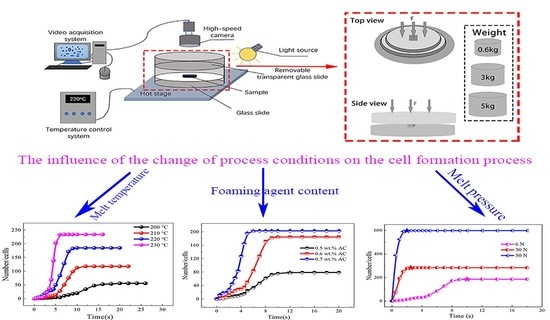In-Situ Visualization of the Cell Formation Process of Foamed Polypropylene under Different Foaming Environments
Abstract
1. Introduction
2. Experimental Section
2.1. Experimental Materials
2.2. Sample Preparation
2.3. Injection Molding Experiment
2.4. Visualization Device
3. Results and Discussion
3.1. Effect of Melt Temperature on Cell Formation
3.2. Effect of Foaming Agent Content on Cell Formation
3.3. Effect of Melt Pressure on Cell Formation
3.4. Effect of Melt Pressure on Cell Formation in the Actual Injection Molding Process
4. Conclusions
- (1)
- In the free foaming environment, the change in n with t presents three stages: slow increase, rapid increase, and basic stability, irrespective of whether the melt temperature and contents of the foaming agent changed. With the increase in temperature and the foaming agent content, the time of the slow growth stage of the cell number was gradually shortened, and the latter two stages were advanced.
- (2)
- The melt pressure had a significant effect on the process of cell formation. With increasing melt pressure, the n-t curve changed from a complete “S” shape to a “semi-S” shape. This change presented two stages of “rapid increase and basic stability”, the absence of a slow increase in cell number, and the rate of cell formation increased significantly. With increasing melt pressure, the cell can form in advance.
- (3)
- In the actual dynamic foaming process of injection molding, under the condition of a short-shot injection process, the n-t curve exhibited a typical “S” shape. Under the condition of the core-back injection process, the n-t curve changed from the complete “S” shape to the “semi-S” shape. This meant the cell formation presented only two stages; there was the absence of a slow formation stage, and the formation rate of new cells increased significantly. The cell formation laws of the actual injection dynamic foaming process were consistent with the influential law in the free foaming environment.
Author Contributions
Funding
Institutional Review Board Statement
Informed Consent Statement
Data Availability Statement
Conflicts of Interest
References
- Wang, G.; Wang, L.; Mark, L.H.; Shaayegan, V.; Wang, G.; Li, H.; Zhao, G.; Park, C.B. Ultralow-Threshold and lightweight biodegradable porous PLA/MWCNT with segregated conductive networks for high-performance thermal insulation and electromagnetic interference shielding applications. ACS Appl. Mater. Interfaces 2018, 10, 1195–1203. [Google Scholar] [CrossRef] [PubMed]
- Wang, G.; Zhao, J.; Wang, G.; Mark, L.H.; Park, C.B.; Zhao, G. Low-density and structure-tunable microcellular PMMA foams with improved thermal-insulation and compressive mechanical properties. Eur. Polym. J. 2017, 95, 382–393. [Google Scholar] [CrossRef]
- Hajibabazadeh, S.; Palahang, M.; Razavi Aghjeh, M.K. Effect of morphology development on mechanical properties and fracture behavior of PP/EPDM/SiO2 blend-nanocomposites. Polym. Test. 2019, 73, 124–134. [Google Scholar] [CrossRef]
- Gong, W.; Zhang, C.; Yu, J.; He, Y.; He, L. Injection Processing and Foaming Behaviors of Polypropylene Composite Foams. Wuhan Univ. J. Nat. Sci. 2014, 19, 123–128. [Google Scholar] [CrossRef]
- Raps, D.; Hossieny, N.; Park, C.B.; Altstadt, V. Past and present developments in polymer bead foams and bead foaming technology. Polymer 2015, 56, 5–19. [Google Scholar] [CrossRef]
- Zhang, C. Preparation of High-Quality Chemical Foaming Polyolefin Materials and Research on the Fracture Mechanical Behavior. PhD Thesis, Shanghai University, Shanghai, China, 2009. [Google Scholar]
- Shimoda, M.; Tsujimura, I.; Tanigaki, M.; Ohshima, M. Polymeric foaming simulation for extrusion processes. J. Cell. Plast. 2001, 37, 517–536. [Google Scholar] [CrossRef]
- Ameli, A.; Nofar, M.; Wang, S.; Park, C.B. Lightweight polypropylene/stainless-steel fiber composite foams with low percolation for efficient electromagnetic interference shielding. ACS Appl. Mater. Interfaces 2014, 6, 11091. [Google Scholar] [CrossRef] [PubMed]
- Ameli, A.; Nofar, M.; Jahani, D.; Rizvi, G.; Park, C.B. Development of high void fraction polylactide composite foams using injection molding: Crystallization and foaming behaviors. Chem. Eng. J. 2015, 262, 78–87. [Google Scholar] [CrossRef]
- Han, C.D.; Villamizar, C.A. Studies on structural foam processing I. The rheology of foam extrusion. Polym. Eng. Sci. 2004, 18, 687–698. [Google Scholar] [CrossRef]
- Lee, J.; Turng, L.S.; Dougherty, E.; Gorton, P. A novel method for improving the surface quality of microcellular injection molded parts. Polymer 2011, 52, 1436–1446. [Google Scholar] [CrossRef]
- Ramesh, N.S.; Malwitz, N. Non-isothermal model to study the influence of blowing agent concentration on polymer viscosity and gas diffusivity in thermoplastic foam extrusion. J. Cell. Plast. 1999, 35, 199–209. [Google Scholar] [CrossRef]
- Rachtanapun, P.; Selke, S.E.M.; Matuana, L.M. Effect of the high-density polyethylene melt index on the microcellular foaming of high-density polyethylene/polypropylene blends. J. Appl. Polym. Sci. 2010, 93, 364–371. [Google Scholar] [CrossRef]
- Yang, W.; Zou, W.; Du, Z.; Li, H.; Zhang, C. Enhanced conductive polymer nanocomposite by foam structure and polyelectrolyte encapsulated on carbon nanotubes. Compos. Sci. Technol. 2016, 123, 106–114. [Google Scholar] [CrossRef]
- Liu, S.; Duvigneau, J.; Vancso, G.J. Nanocellular polymer foams as promising high performance thermal insulation materials. Eur. Polym. J. 2015, 65, 33–45. [Google Scholar] [CrossRef]
- Duan, H.D.; He, L.; Jiang, T.; Zhang, C.; Gong, W. Effect of pressure field on micro-foaming behavior of PP Composites. Plast. Sci. Technol. 2014, 42, 44–47. [Google Scholar]
- Pan, L.Y.; Shen, Y.X.; Zhan, M.S.; Wang, K.; Gao, D.L. Visualization study of foaming process for polyimide foams and its reinforced foams. Polym. Compos. 2010, 31, 43–50. [Google Scholar] [CrossRef]
- Chen, L.; Wang, X.; Straff, R.; Blizard, K. Shear stress nucleation in microcellular foaming process. Polym. Eng. Sci. 2002, 42, 1151–1158. [Google Scholar] [CrossRef]
- Mahmoodi, M.; Behravesh, A.H.; Rezavand, S.A.M.; Pashaei, A. Visualization of bubble dynamics in foam injection molding. J. Appl. Polym. Sci. 2010, 116, 3346–3355. [Google Scholar] [CrossRef]
- Pop-Iliev, R.; Dong, N.; Xu, D.; Park, C.B. Visualization of the foaming mechanism of polyethylene blown by chemical blowing agents under ambient pressure. Adv. Polym. Technol. 2010, 26, 213–222. [Google Scholar] [CrossRef]
- Leung, S.N.; Wong, A.; Guo, Q.; Park, C.B.; Zong, J.H. Change in the critical nucleation radius and its impact on cell stability during polymeric foaming processes. Chem. Eng. Sci. 2009, 64, 4899–4907. [Google Scholar] [CrossRef]
- Taki, K.; Yanagimoto, T.; Funami, E.; Okamoto, M.; Ohshima, M. Visual observation of CO2 foaming of polypropylene-clay nanocomposites. Polym. Eng. Sci. 2004, 44, 1004–1011. [Google Scholar] [CrossRef]
- Wong, A.; Chu, R.K.; Leung, S.N.; Park, C.B.; Zong, J.H. A batch foaming visualization system with extensional stress-inducing ability. Chem. Eng. Sci. 2011, 66, 55–63. [Google Scholar] [CrossRef]
- Wong, A.; Guo, Y.; Park, C.B.; Zhou, N.Q. A polymer visualization system with accurate heating and cooling control and high-speed imaging. Int. J. Mol. Sci. 2015, 16, 9196–9216. [Google Scholar] [CrossRef]
- Huang, B. Study on the Dynamic Foaming Process of Polypropylene with the Visualization Method. Master’s Thesis, Guizhou University, Guizhou, China, 2017. [Google Scholar]
- Wu, S.; He, L.; Zhang, C.; Gong, W.; He, Y.; Luo, Y. Visualization observation of cells growth in low-density polyethylene foaming processes. Polym. Test. 2017, 63, 367–374. [Google Scholar] [CrossRef]
- Gao, P. Study on the Cell Formation and Growth Process of Polymer Foam. Master’s Thesis, Guizhou University, Guizhou, China, 2016. [Google Scholar]
- He, Y.; Jiang, T.H.; Liu, Y.F. Influence of rubber powders on foaming behavior and mechanical properties of foamed polypropylene composites. Mater. Eng. 2017, 45, 80–87. [Google Scholar]
- Yang, J.; Jiang, T.; Liu, B.; Zhang, C.; Zeng, X.; He, L.; Gong, W. Experimental and numerical analysis of bubble nucleation in foaming polymer. Mater. Des. 2021, 203, 109577. [Google Scholar] [CrossRef]
- Li, C.; Feng, L.F.; Gu, X.P.; Cao, K.; Zhang, C.L. In situ visualization on formation mechanism of bi-modal foam via a two-step depressurization approach. J. Supercrit. Fluids 2017, 135, 8–16. [Google Scholar] [CrossRef]
- Shaayegan, V.; Wang, G.; Park, C.B. Study of the bubble nucleation and growth mechanisms in high-pressure foam injection molding through in-situ visualization. Eur. Polym. J. 2016, 76, 2–13. [Google Scholar] [CrossRef]
- Shaayegan, V.; Mark, L.H.; Park, C.B.; Wang, G. Identification of cell-nucleation mechanism in foam injection molding with gas-counter pressure via mold visualization. AIChE J. 2016, 62, 4035–4046. [Google Scholar] [CrossRef]
- Guo, Q.; Wang, J.; Park, C.B.; Ohshima, M. A microcellular foaming simulation system with a high pressure-drop rate. Ind. Eng. Chem. Res. 2006, 45, 6153–6161. [Google Scholar] [CrossRef]
- Ishikawa, T.; Ohshima, M. Visual observation and numerical studies of polymer foaming behavior of polypropylene/carbon dioxide system in a core-back injection molding process. Polym. Eng. Sci. 2011, 51, 1617–1625. [Google Scholar] [CrossRef]
- Ishikawa, T.; Taki, K.; Ohshima, M. Visual observation and numerical studies of N2 vs. CO2 foaming behavior in core-back foam injection molding. Polym. Eng. Sci. 2012. [Google Scholar] [CrossRef]
- Yamada, T.; Murata, Y.; Yokoi, H. Visualization analysis of a multilayer foam development process in microcellular injection molding. Int. Polym. Process. J. Polym. Process. Soc. 2012, 27, 299–309. [Google Scholar] [CrossRef]
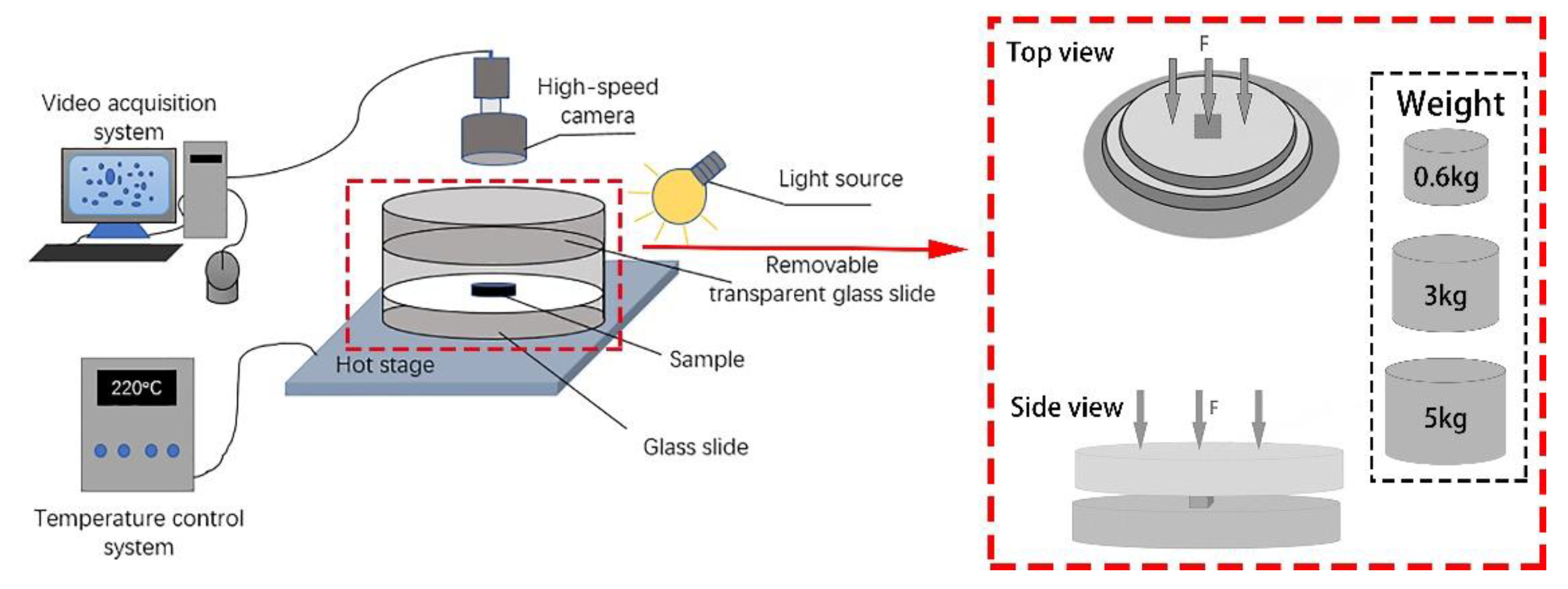

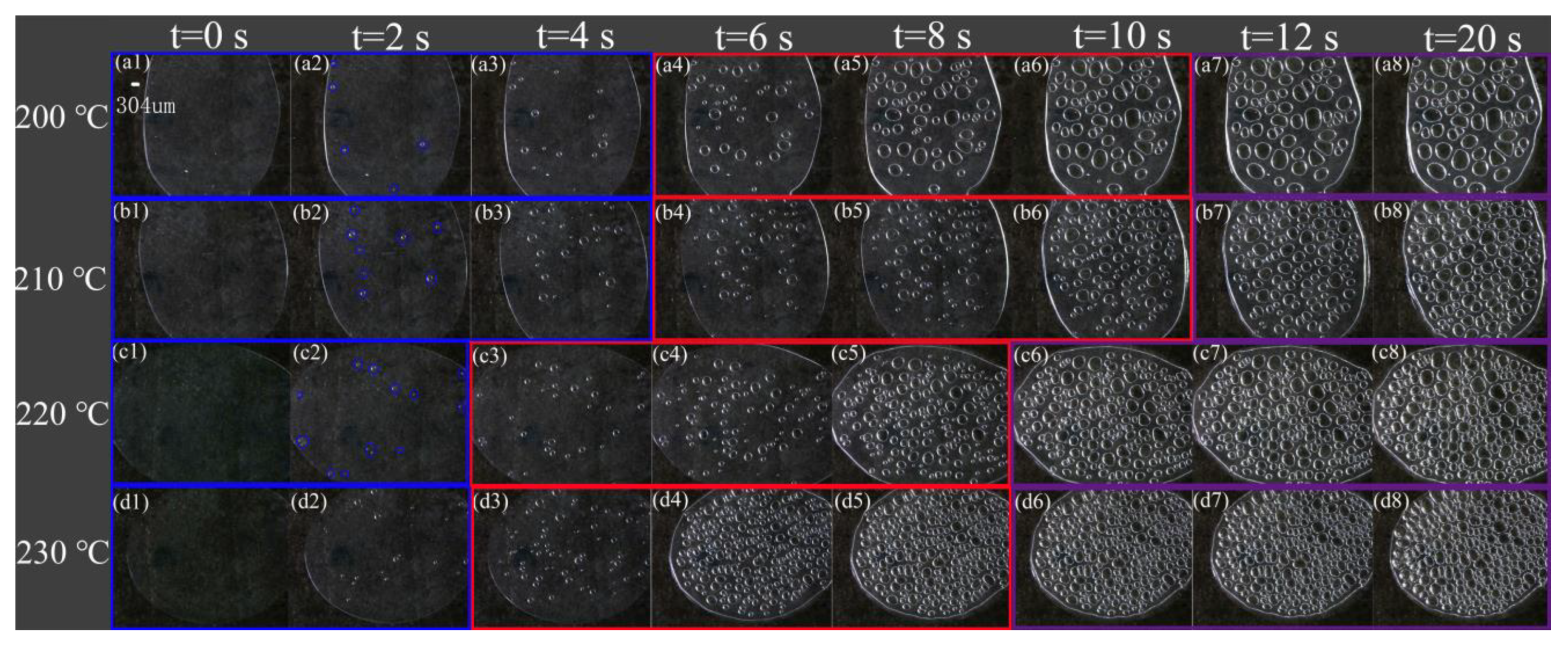
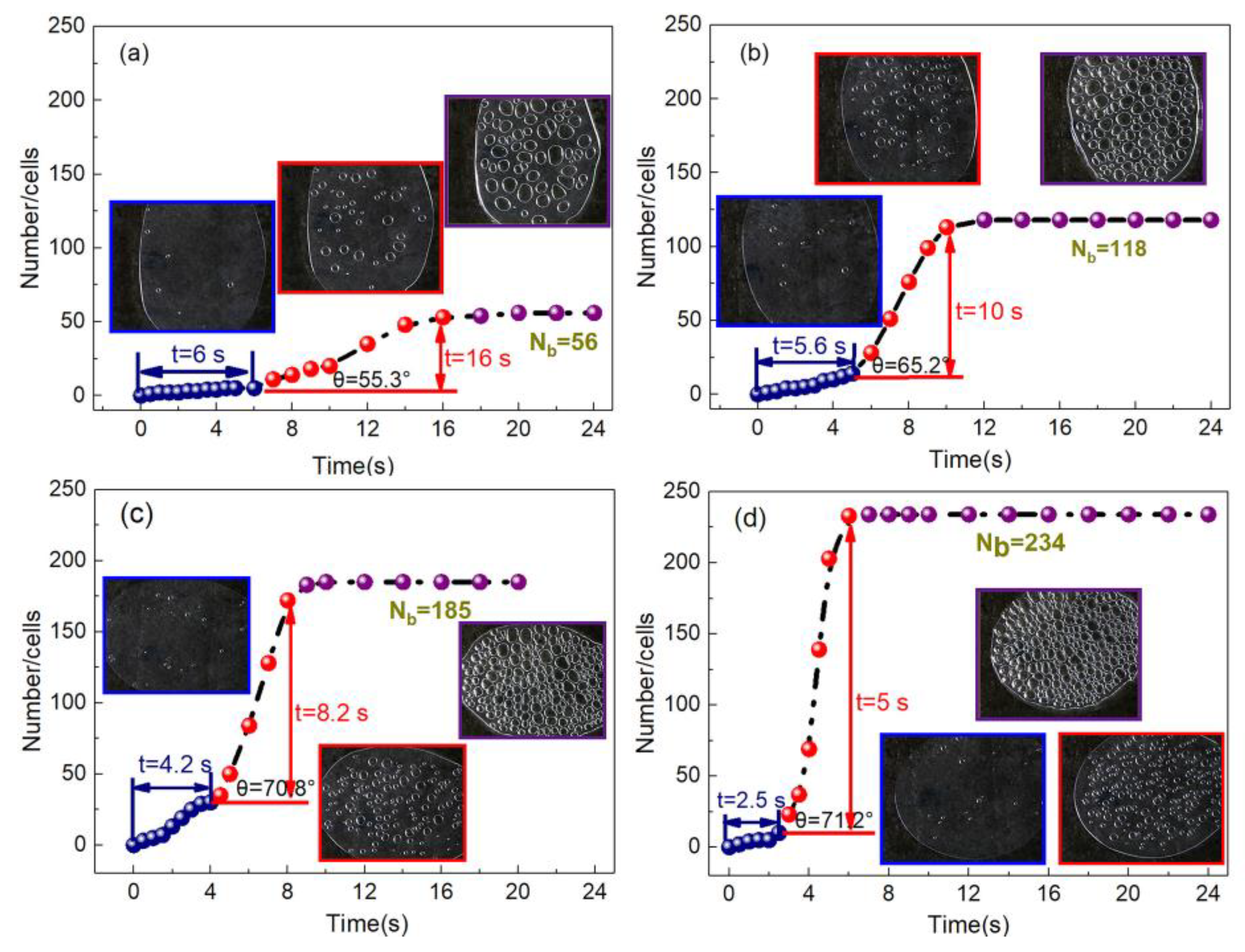
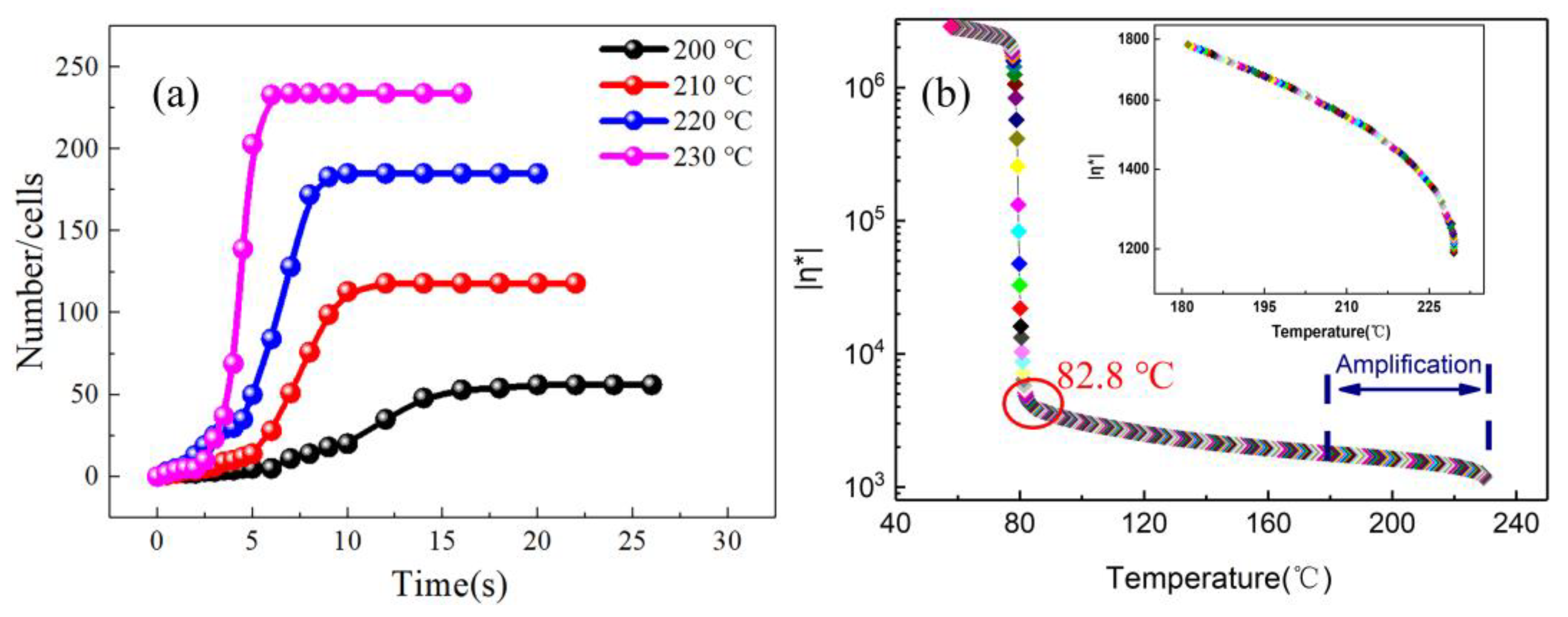


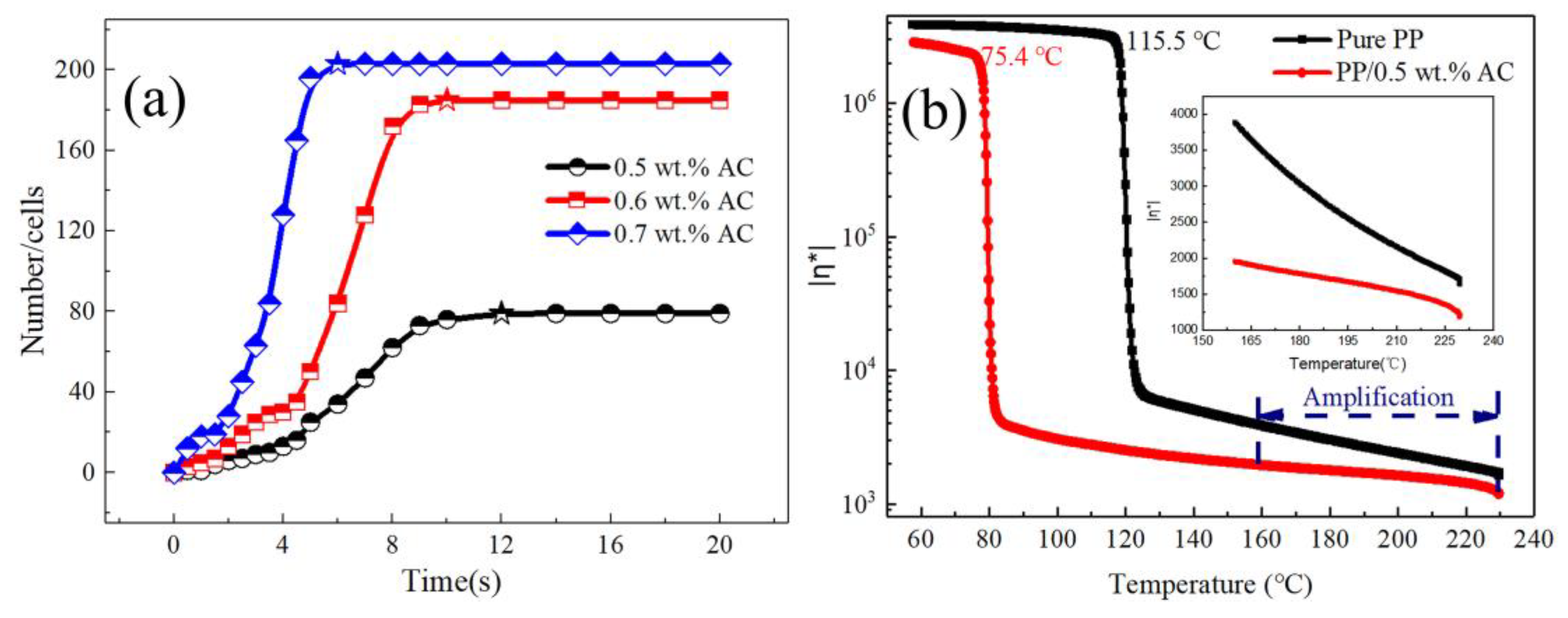
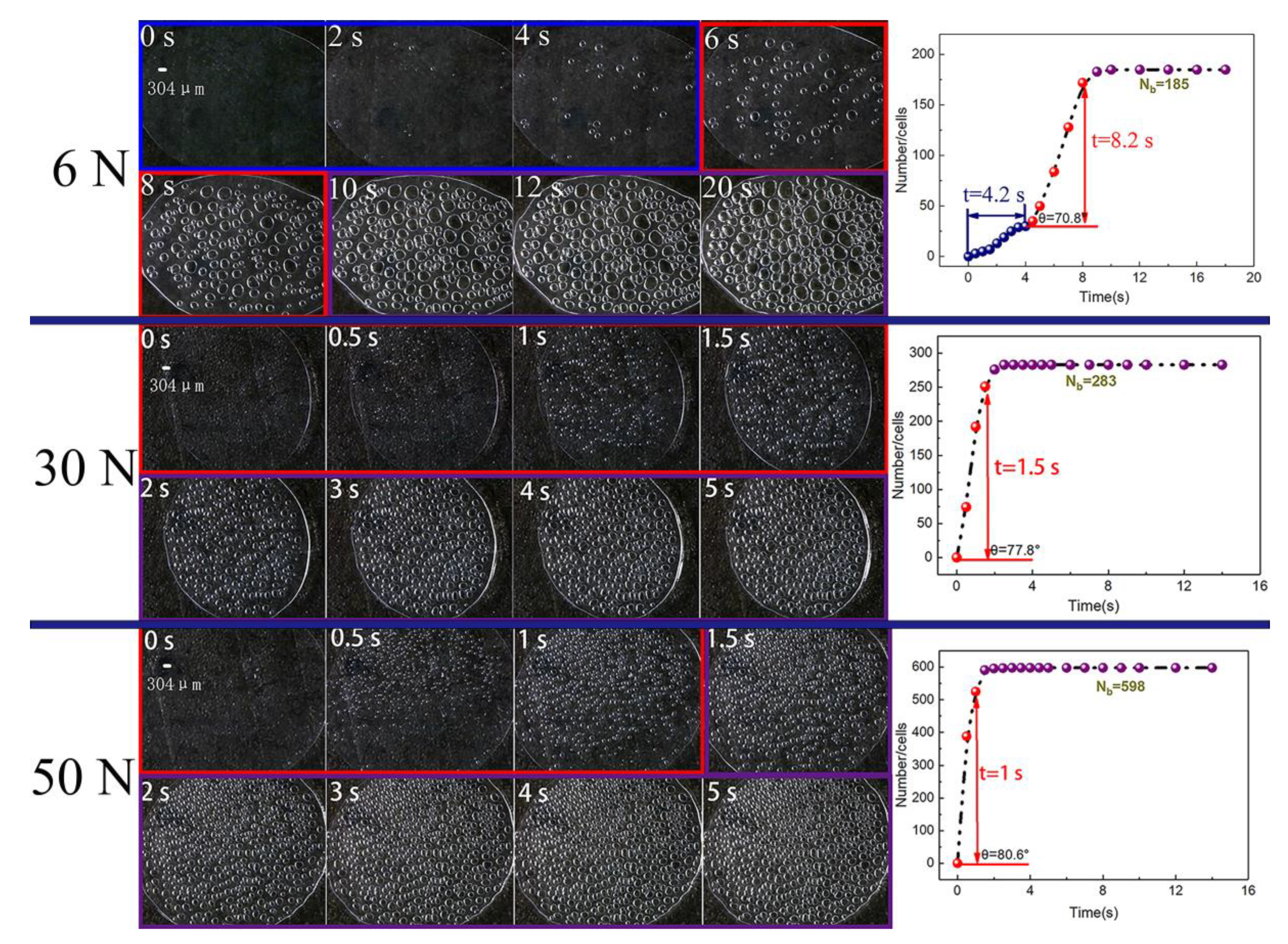
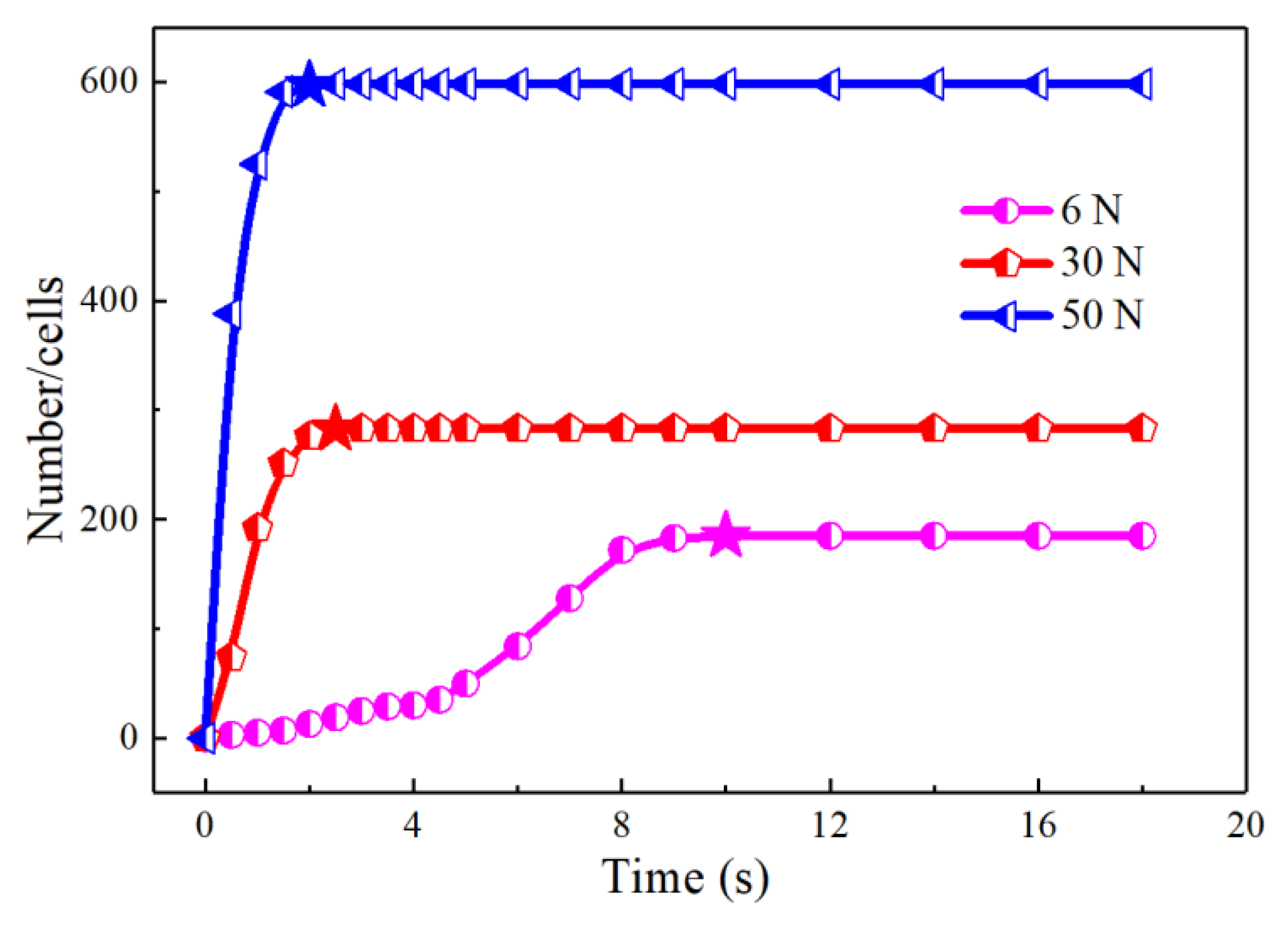
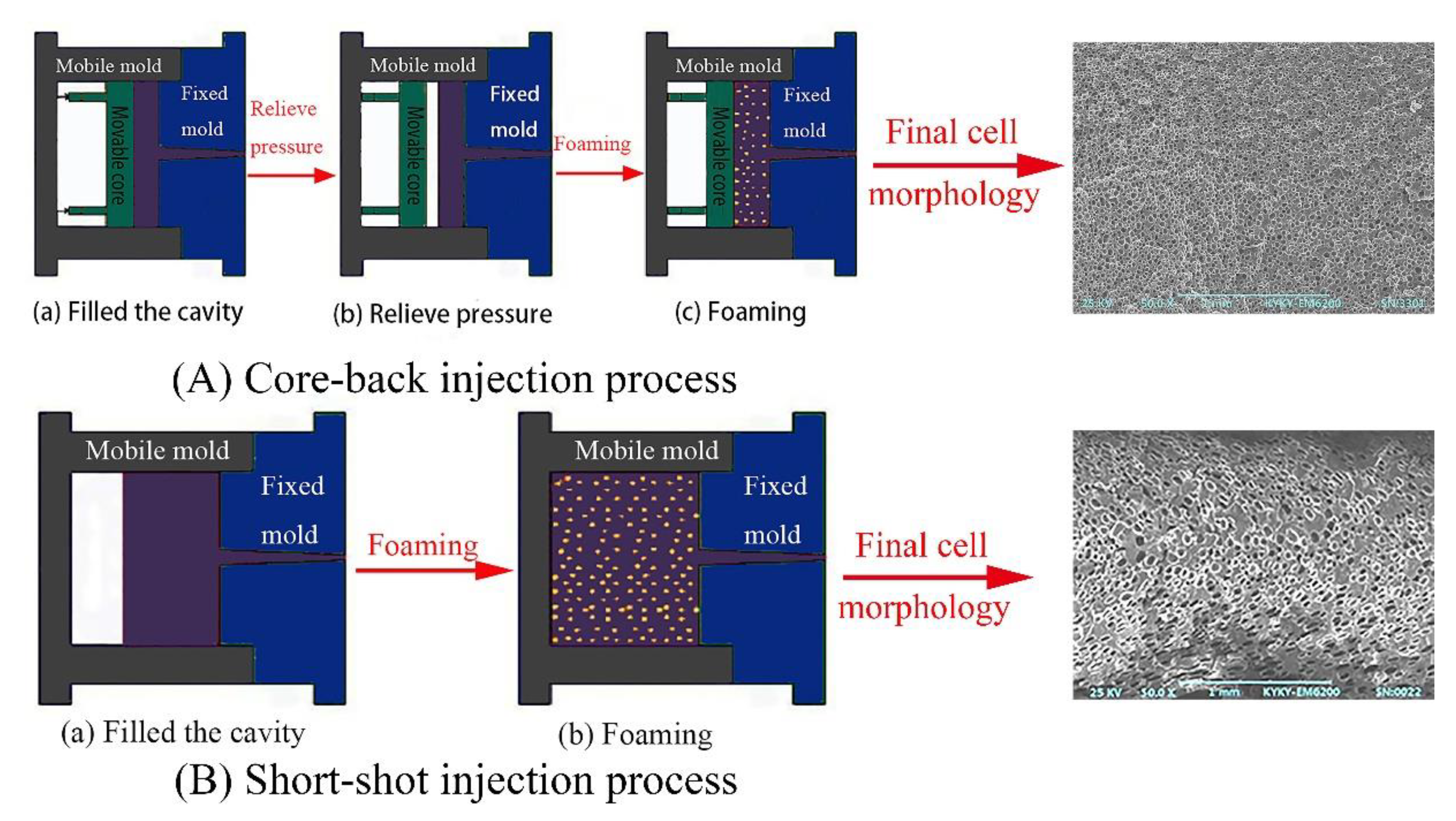

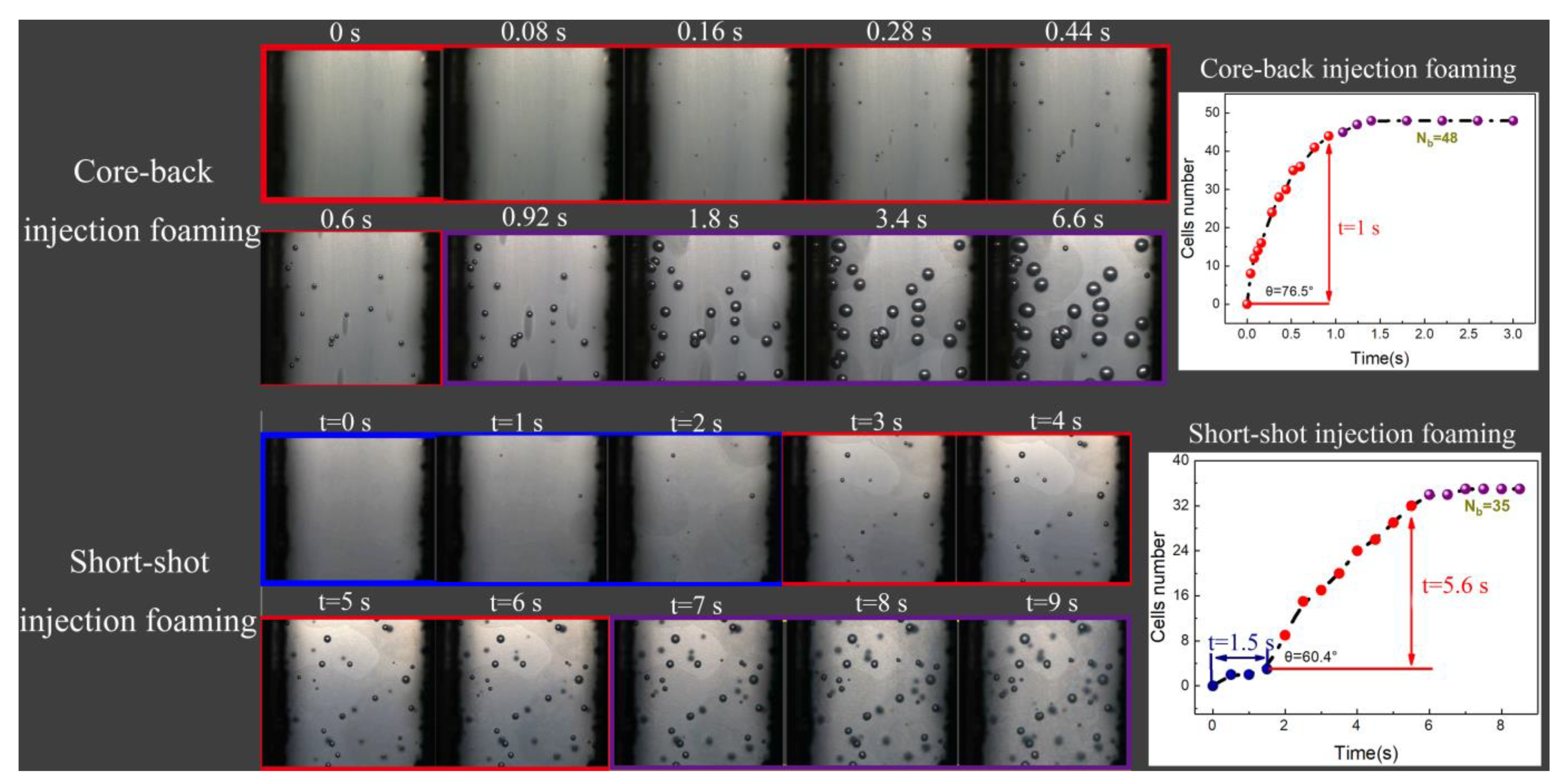
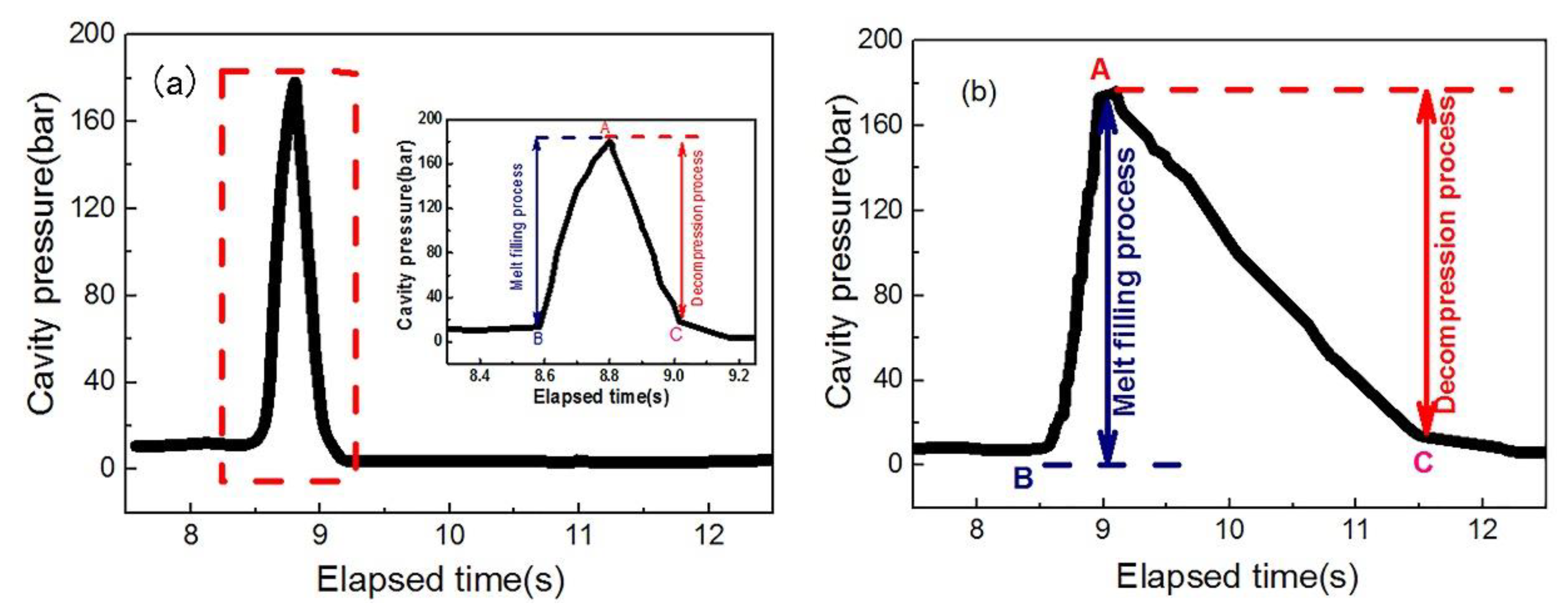
| Component | PP | Foaming Agent Masterbatch |
|---|---|---|
| 1 | 99.5 wt.% | 0.5 wt.% |
| 2 | 99.4 wt.% | 0.6 wt.% |
| 3 | 99.3 wt.% | 0.7 wt.% |
| Molding Process | Melt Temperature | Injection Speed | Injection Pressure | Injection Volume | Mold Opening Distance | AC Content |
|---|---|---|---|---|---|---|
| Core-back injection | 200 °C | 30% | 40 bars | 22 mm | 0.6 mm | 0.6 wt.% |
| Short-shot injection | 200 °C | 30% | 40 bars | 22 mm | ---- | 0.6 wt.% |
| Melt Temperature | N1 | τ | n | T | ΔG | a | R2 |
|---|---|---|---|---|---|---|---|
| 200 °C | 2000 | 10.3 | 0.42 | 473 | 38.35 | 0 | 0.9945 |
| 210 °C | 2000 | 7.2 | 0.75 | 483 | 34.2 | 0 | 0.9961 |
| 220 °C | 2000 | 6.4 | 0.9 | 493 | 31.25 | 0 | 0.9921 |
| 230 °C | 2000 | 4.3 | 1.9 | 503 | 30.9 | 0 | 0.9963 |
| Content of Foaming Agent | N1 | τ | n | T | ΔG | a | R2 |
|---|---|---|---|---|---|---|---|
| 0.5 wt.% | 2000 | 6.6 | 0.7 | 493 | 32.9 | 0 | 0.9970 |
| 0.6 wt.% | 2000 | 6.4 | 0.9 | 493 | 31.25 | 0 | 0.9921 |
| 0.7 wt.% | 2000 | 3.5 | 1.4 | 493 | 31.25 | 0 | 0.9954 |
| Melt Pressure | N1 | τ (s) | n | T (K) | G (kJ) | a | R2 |
|---|---|---|---|---|---|---|---|
| 6N | 2000 | 1.8 | 2.8 | 493 | 32.9 | 0 | 0.9897 |
| 30N | 2000 | 0.7 | 4.4 | 493 | 28.7 | 0.006 | 0.9890 |
| 50N | 2000 | 0.5 | 6.5 | 493 | 23.65 | 0.01 | 0.9703 |
Publisher’s Note: MDPI stays neutral with regard to jurisdictional claims in published maps and institutional affiliations. |
© 2021 by the authors. Licensee MDPI, Basel, Switzerland. This article is an open access article distributed under the terms and conditions of the Creative Commons Attribution (CC BY) license (https://creativecommons.org/licenses/by/4.0/).
Share and Cite
Deng, R.; Jiang, T.; Zhang, C.; Zeng, X.; Liu, B.; Yang, J.; Li, S.; Gu, J.; Gong, W.; He, L. In-Situ Visualization of the Cell Formation Process of Foamed Polypropylene under Different Foaming Environments. Polymers 2021, 13, 1468. https://doi.org/10.3390/polym13091468
Deng R, Jiang T, Zhang C, Zeng X, Liu B, Yang J, Li S, Gu J, Gong W, He L. In-Situ Visualization of the Cell Formation Process of Foamed Polypropylene under Different Foaming Environments. Polymers. 2021; 13(9):1468. https://doi.org/10.3390/polym13091468
Chicago/Turabian StyleDeng, Rong, Tuanhui Jiang, Chun Zhang, Xiangbu Zeng, Bujin Liu, Jingkui Yang, Shengnan Li, Jun Gu, Wei Gong, and Li He. 2021. "In-Situ Visualization of the Cell Formation Process of Foamed Polypropylene under Different Foaming Environments" Polymers 13, no. 9: 1468. https://doi.org/10.3390/polym13091468
APA StyleDeng, R., Jiang, T., Zhang, C., Zeng, X., Liu, B., Yang, J., Li, S., Gu, J., Gong, W., & He, L. (2021). In-Situ Visualization of the Cell Formation Process of Foamed Polypropylene under Different Foaming Environments. Polymers, 13(9), 1468. https://doi.org/10.3390/polym13091468




